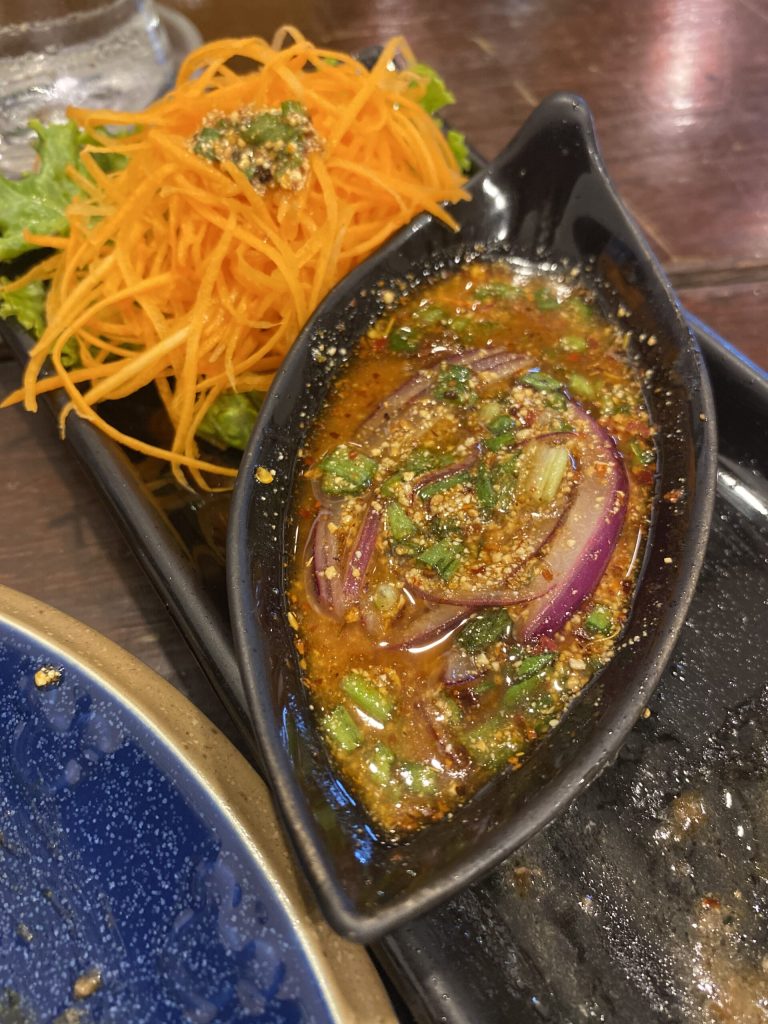The Kor moo yang is the Thai grilled pork neck, usually accompanied by a Nam jim, a Thai term meaning “dipping sauce” with various combinations of sweet, salty, tangy, and spicy flavors, here Nam jim chaeo made with toasted rice and chili.
The Thai grilled pork neck is a type of grilled meat most commonly associated with the Isan or northeastern Thai cuisine.
The name “kor moo yang” in Thai, translates to “grilled pork neck”.
The cut of meat is usually sold by weight along with sticky rice packed in transparent plastic bags.
In the photo, the Kor moo yang with Nam jim chaeo tasted at “Thanya kitchen” during the first part of my trip to Ao Nang in October 2024.
Other Thai pork-based recipes:

- Difficulty: Easy
- Rest time: 30 Minutes
- Preparation time: 10 Minutes
- Portions: 4People
- Cooking methods: Oven
- Cuisine: Thai
- Seasonality: All seasons
Ingredients
- 2.2 lbs pork neck (or pork shoulder)
- 1 1/2 tbsp oyster sauce
- 2 tbsps soy sauce
- to taste white pepper
- 3 shallots
- 1 spring onion
- 2 tbsps fish sauce
- 1 tbsp palm sugar
- 1/2 lime
- to taste coriander
- 2 tbsps jasmine rice
- 2 tbsps red chilies
Steps
In a large bowl, mix the oyster sauce, soy sauce, ground white pepper, and 1 tablespoon of water to prepare a marinade.
Add the pork neck to the bowl. Take a fork and make holes so the pork absorbs the marinade.
Cover the bowl with plastic wrap and let it marinate in the refrigerator for 30 minutes.
After 30 minutes, preheat the oven to 392°F.Place the pork on a rack and bake for 30 minutes, turning it to the other side halfway through the cooking time.
To prepare the dipping sauce, toast dried red chilies over low heat for 1-2 minutes, then blend them to a fine powder.
Toast the dry rice and then crush it in a mortar.Peel and finely slice the shallots and coriander, slice the spring onion.
Add the ground chili, palm sugar, fish sauce, and a squeeze of lime to a bowl. Finally, the toasted rice powder. Mix.
Turn off the oven. Transfer the pork to a cutting board and slice it to serve with the Nam chim chaeo sauce.
FAQ (Frequently Asked Questions)
What are the different types of Thai nam jim or nam chim?
Nam chim kai, the sweet chili sauce is a very common all-around chili sauce with the consistency of a thick syrup.
It is moderately spicy and very sweet, usually referred to as “sweet Thai chili sauce” in English, often used as a dipping sauce for grilled chicken (kai yang).
It can be used as a generic chili sauce for other dishes.
It is the base of other types of nam jim such as nam chim chiot man pla.
Nam chim chaeo using roasted sticky rice, this sauce is often consumed with kor moo yang or kai yang (grilled chicken).
Nam chim sate, the Thai version of peanut sauce; it is eaten with Thai satay.
Served with achat the Thai version of the acar timun Malaysian/Indonesian (sweet and sour cucumber).
The Thai variety consists of fresh chopped cucumber, spring onion, and chili, mixed with vinegar.
Nam chim suki accompanies Thai suki (the Thai version of the Chinese hot pot) and Mu kratha. The main ingredients are chili sauce, chili, garlic, and sesame seeds.
Nam chim taochiao, containing yellow soybean paste (taochiao), eaten with khao man kai, stir-fried rice with chicken.
Nam chim thale : a basic dipping sauce made of garlic, fish sauce, lime juice, sugar, and chili usually eaten with grilled or steamed fish.
Nam chim thot man, served with thot man pla (fried fish cakes), is similar to nam chim kai but with chopped cucumber, spring onion, and coriander leaves. For thot man kung or pu (fried shrimp or crab cakes), however, a very sweet plum sauce is served instead.
Nam chim paesa served as a sauce for steamed cabbage-wrapped cooked fish.

